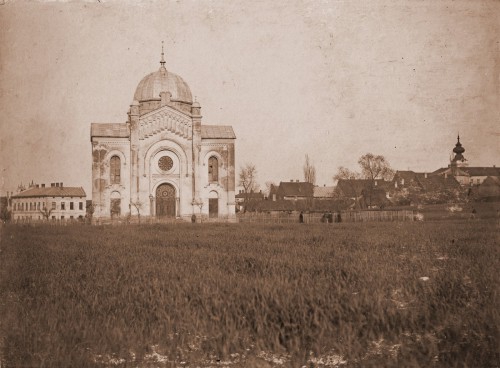I can see in front of my eyes a picture of Jews going to the synagogue on Saturday, which was located in the back of our middle school. Both religious groups, the Catholics and Jews, were united, I suppose, by the awareness that they pray to the same God. Despite the difference in language, the prayers in the church and in the synagogue were largely based on the same texts.
John Paul II
The beginnings of the Jewish community in Wadowice date back to the Galician times. Most of them were engaged in trade and craft. In 1880, they constituted over 8 % of the total population of the town (404 people), and on the eve of the outbreak of the Second World War, they made up about 20% (2,000 people) of the total population of the town. With the growth of the Jewish population in Wadowice, the Jewish community erected a brick synagogue in the style of modern western synagogues (1885-1889), designed by the eminent architect Karol Korn from Bielsko-Biała. Today there is no trace of the temple, because in the autumn of 1939 it was burnt down by the Germans and its remains were blown up a year later.
Karol Wojtyła grew up in the atmosphere of two cultures and two religions. Among his schoolmates and playmates there were the Jews of Wadowice, and one of them, Jerzy Kluger, was one of his closest friends. The beginnings of the friendship with the Jewish boy date back to the times of elementary school. One day Jerzy was looking for Lolek to pass on urgent news to him - they both got accepted to the middle school. He entered the parish church, which was surprising to one of the women, who was supposed to say: Well, and you are the son of the President of the Jewish Community! And the young Wojtyła supposedly answered in the following way: Aren't we all children of one God?
Both boys used to visit each other a lot. Karol would come to the Klugers to listen to the radio. In addition, Jerzy's father, Wilhelm, ran a string quartet and they had rehearsal twice a week, and Karol appeared at the rehearsals to listen to the music. In 1936, the young Karol Wojtyła was invited to the Wadowice synagogue by W. Kluger for a special concert of the famous tenor Mojsze Kusewicki. It was probably the first time that the future pope walked out the door of a temple of another religion.
In 1989, on the anniversary of the liquidation of the Wadowice Ghetto (1943), a plaque commemorating the Jews murdered by the Germans during the war was placed on the building standing in the place of the synagogue. Jerzy Kluger, a friend of the Pope's, also came to the meeting of Holocaust survivors. He read out a letter addressed to the audience on the pope's behalf: ‘The Church, and in this Church, all peoples and nations, feel united to you in this mission. Certainly, they give great prominence to your nation and its sufferings, its Holocaust, when they wish to speak a warning to individuals and to nations; in your name, the pope, too, lifts up his voice in this warning. The Polish pope has a particular relationship with all this, because, along with you, he has in a certain sense lived all this here, in this land.’
The Pontificate of John Paul II became a time of reconciliation between Christians and Jews. The Pope treated the followers of Judaism ‘as our beloved older brethren in the faith’.
In 2003, The Polish Council of Christians and Jews awarded Kluger the title of the “Man of Reconciliation”. The last time Jerzy saw John Paul II a few days before his death in 2005. A Pope's friend died in 2011 and is buried in the Jewish cemetery in Rome.
Currently, in the place of the former synagogue in Wadowice, in the 1950s a public kindergarten was built.

